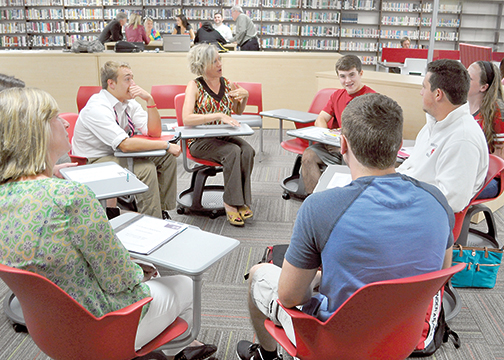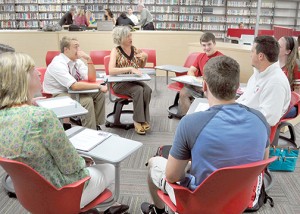

Editor
The Work Readiness Initiative is continuing to make a difference in Clermont County, both for students as they plan for the future and for the relationships between schools and businesses.
The program was started by members of a LEAD Clermont group. Some employers were talking about what was lacking in today’s hires, and it kept coming up that new hires had the education but not the softer skills, such as how to dress professionally, said Susan McHugh, Clermont Chamber of Commerce Foundation project manager.
Amanda Davenport, of Fifth Third Bank, and Kurtis Taylor, of Tata Consultancy, presented the first group of lessons, which they created, at Williamsburg High School three years ago. Since the program has adapted slightly, but remains mostly the same, McHugh said.
Now, volunteers teach the classes. Teachers pick the topics based on what they feel their class needs to learn the most. Four or five volunteers attend each class. One gives the introduction to the lesson and then the others break the students up into groups to discuss the topic with them, McHugh said.
“It’s basically all the things our parents tell us but we don’t listen to when we’re teenagers,” McHugh said.
Topics include dependability, employee expectations, resume building, interviewing skills and financial literacy.
The volunteers also make themselves available should the students have any questions or need advice, which students have utilized, McHugh said.
The program at New Richmond High School is unique in that the school board wrote it to make it a four credit class. The guidance counselor and high school principal chose the topics, McHugh said.
“It is just truly unbelievable the response we have gotten from the business community,” McHugh said.
The volunteers and mentors range from a county commissioner to a judge to an entrepreneur, McHugh said. There are currently 58 volunteers presenting Work Readiness Skills and another 50 volunteers who are involved in other Work Readiness programs.
“It’s amazing the breadth of knowledge and experience that these people have,” McHugh said.
Right now, McHugh is recruiting volunteers for classes that begin at the end of January. The number of sessions range from six to 16, depending on the school district, and each last about a hour. Contact McHugh at susanmchughmail@gmail.com or 513-260-1085 if interested.
The Work Readiness Initiative has short term, mid term and long term outcomes. The short term outcomes were for the 2014-2015 school year. McHugh aims to complete the mid term outcomes by the end of the 2016-2017 school year and the long term by the end of the 2019-2020 school year.
The program has achieved all the short term outcomes. McHugh was pleasantly surprised to find that school administrators were interested and cooperative, they just wanted to make sure the program was sustainable before implementing it.
McHugh and others involved had to do a lot of trust building with the schools to show them that the program would stay and that it wasn’t just business people writing a check, but that they would be there for the long term.
One district didn’t get involved until it saw the results the other area schools were getting from the program. Now that district even contacts members of the business community for advice.
“They’re looking at the business community as a partner,” McHugh said.
The program is progressing towards the mid term goals well. So far, the public is starting to recognize and promote the program and the word is getting out to parents. Some parents are even calling and asking if the program is available in their child’s school, McHugh said.
In addition to helping students, the program aims to be a catalyst to make connections between businesses, schools and the government, McHugh said.
McHugh believes that having this program could benefit the county by making it more attractive to businesses considering locating in the county. She has learned from Matt Van Sant, chamber president/chief executive officer, that businesses do not come just for a tax break, they come for the workforce that is already here, and the potential for an ongoing workforce.
If there is not a good relationship between the business and the education community, it could hurt the county’s growth, but if the chamber can say that hundreds of volunteers from local businesses work with county students, that will peak a business owner’s interest, McHugh said.
In the long term, McHugh hopes the program will help people work together and learn more about each other. She believes this will help adults see that students are not like what is shown on the news.
“These kids are for the most part kids who really want to do well, they just need advice sometimes,” McHugh said.
Other long term goals include Clermont County students staying in the county because of relationships established in the program and employers hiring students because of relationships established in the program.
She hopes to add a job shadowing day and internships to the program.
Also part of the Initiative are district development programs, which are offered by professionals who are experts in their field. The programs are Foundation Development, Technology Expertise, Staff Development and Training, Marketing/School levy Promotion and Resource Sharing.
A more recent addition to the initiative, the mentorship program, which began in the fall of 2015, is a success so far.
“It’s going well. We have approximately 140 individual mentors and 140 students. They are in every Clermont County high school,” McHugh said.
The mentors and the students meet once or twice a month and talk about everything from career plans to weekend plans. Her goal was to have 50 mentors, so she is excited to have so many, McHugh said.
McHugh hasn’t heard much from the students yet, but all of the mentors she has heard from have had positive responses. She hears from many that the students are quiet and a bit shy.
The students and mentors meet for the length of a class period at the students’ school. Right now there are sophomore and juniors in the program. Next year McHugh hopes to add more mentors and start students as sophomores so that they have three years with a mentor, she said.
